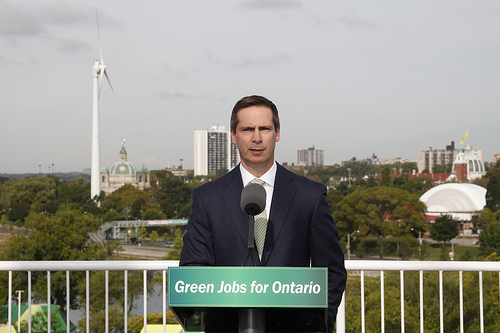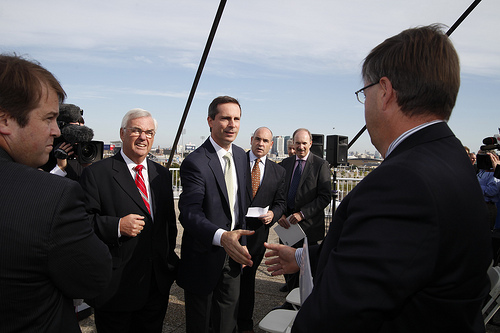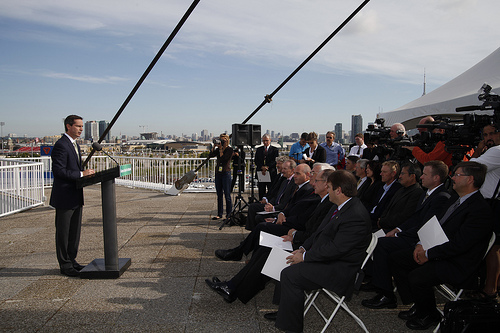
On Thursday September 24, Ontario Premier Dalton McGuinty, along with Energy Minister George Smitherman and Environment Minister John Gerretsen, announced the crucial details that will allow a wave of new renewable energy projects to get underway in Ontario. Central to the government’s policy agenda, the Feed In Tariff (FIT) program will offer guaranteed prices to producers of renewable electricity in Ontario under long-term contracts. The program is officially open for business as of October 1. A series of online resources for developers became available on September 30 to assist them with assessing technical options and the application process.
Heralded as “North America's first comprehensive feed-in tariff program,” the initiative has attracted widespread interest in the power industry both within Ontario and from outside its borders. “This is a very bold step toward the future and it will change the way we think about the electricity system and its relationship to our society,” APPrO president Dave Butters said.
“Ontario has taken the lead in Canada and set the ground rules for doing green business. Now investors, renewable energy companies and skilled workers can really move our green economy forward,” said Premier McGuinty. Minister Smitherman observed that, “Ontario wants green energy business. These regulations will help ensure industry and municipalities that jobs will be created, investment is committed and that the renewable energy industry grows across the province.” Minister Gerretsen added that, “These changes not only give us an economic advantage, they will protect our environment, combat climate change and create a healthier future for Ontarians.”
A series of consultations held on the FIT program by the Ontario Power Authority between March and June of this year helped develop the basic outlines of the program and heightened industry expectations. The rules are designed not just to bring forward large amounts of renewable energy but also to encourage the development of power projects by a range of entities including First Nations and Métis communities, homeowners, farmers, schools, stores, factories, co-ops, offices and larger-scale commercial generators.

The Feed In Tariff Program was among the initiatives that needed to be finalized to enable the implementation of the province’s Green Energy Act. It is part of a series of initiatives brought forward in September titled “Ontario's Ten Steps To Green Energy.” The steps include the following:
1. Closure of four coal-fuelled power units in 2010, four years ahead of the 2014 target.
2. The Aboriginal Energy Partnerships Program, to build capacity and participation through support for community energy plans, funding for feasibility studies and the development of an Aboriginal Renewable Energy Network.
3. The Aboriginal Loan Guarantee program (ALGP) which makes Aboriginal communities eligible for loan guarantees to take on equity participation in renewable generation and transmission projects.
4. Grid development: Instructing Hydro One to begin work on 20 transmission and distribution projects over the next three years. Six core transmission network upgrades are moving forward, including North-South lines from Sudbury to Barrie and Barrie to the Greater Toronto Area and an East-West line from Nipigon to Wawa. Another series of core-supporting transmission projects and distribution upgrades are also moving ahead.
5. The Community Energy Partnerships Program, which will assist communities in Ontario, including farmers, co-ops and non-profit organizations, to bring forward green energy projects by providing one-time support with the "soft" or developmental costs.
6. The Municipal Renewable Energy Program, which will provide support to municipalities for costs associated with new renewable energy projects.
7. Establishment of the Renewable Energy Facilitation Office (REFO), a one-window access point to assist developers, communities and municipalities obtain information on developing renewable energy projects in Ontario, and help them navigate through the regulatory approvals necessary to develop projects.
8. The Renewable Energy Approval (REA) process becomes law, intended to simplify and expedite the process of obtaining permits and approvals for renewable energy projects, in a way that is “protective of human health, the environment, and Ontario's cultural and natural heritage.”
9. Domestic content requirements which would ensure at least 25 per cent of wind projects and 50 per cent of large solar projects be produced in Ontario.
10. The Feed In Tariff Program.
These steps were largely made possible through the changes created by the Green Energy Act, introduced in February 2009.
Developers and others in the power industry will likely be focusing intently in the coming weeks on learning the details of three major aspects of the green energy program: The Feed In Tariff rules and contracts, the Renewable Energy Approval process and the domestic content requirements. Under the rules as previously developed, projects that meet certain qualifications may be eligible for a relatively rapid contracting process under the program’s initialization period. The Ontario Power Authority has posted a series of background documents on its website in anticipation of a wave of requests and pent up demand for information on contracting opportunities. Those who work with community or Aboriginal groups will of course be studying the new opportunities now available under the Aboriginal Energy Partnerships Program, the Aboriginal Loan Guarantee program, the Community Energy Partnerships Program, and the Municipal Renewable Energy Program.
One of the key issues in the finalization of the program were the rules governing how close new wind turbines may be placed in relation to lot lines, roads and buildings. Additional regulations limit the use of prime agricultural land for solar installations. The new rules, which are much more restrictive than those in place before, were intended to ensure that development could proceed while respecting high environmental standards.

There is also a micro-FIT program for small scale projects, along with simplified environmental and permitting requirements.
Information from the OPA on the Feed-in Tariff Program is available at this location: www.powerauthority.on.ca/FIT
For details on the new approvals process, see the Ministry of Environment at www.ene.gov.on.ca/en/business/green-energy
The Renewable Energy Facilitation Office is available online at www.ontario.ca/renewableenergyprojects
The IESO has launched its Feed-in Tariff (FIT) web site to assist FIT applicants in understanding the process of connecting to Ontario’s electricity grid: www.ieso.ca/imoweb/fit/fit.asp
For more information see also “Community power expected to grow in Ontario,” IPPSO FACTO, September 2009, “APPrO and others file comments on the detailed rules for FIT,” and “APPrO comments on Renewable Energy Approval process,” in the Financial Technical Supplement to this issue of IPPSO FACTO. The next issue of IPPSO FACTO will include additional coverage and details of the Feed In Tariff program.
